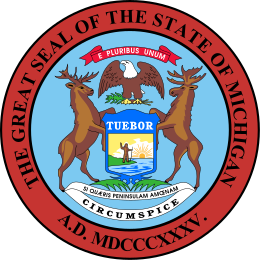Michigan State History
Michigan is a state in the Midwestern region of the United States.
It currently has a population of 9, 987 million people.
Great Lakes
There are lots of lakes in the area so the wider area is also referred to as the Great Lakes Region.
The word Michigan itself comes from the word “mishigami”, which means “large water” or “large lake.”
Related: Michigan State Facts
“Mishigami” is an Ojibwe word . Ojibwe is a language spoken in certain regions of the United States and Canada.
Native Americans in Michigan
In Michigan, some Native Americans spoke Ojibwe.
There were three Native American groups in the state of Michigan: the Algonquin peoples (including the Objibwe (, the Odaawaa/Odawa (Ottawa) and the Boodewaadamii (Potawatomi).
These three groups were part of a confederation called the Council of Three Fires.
The Council of Three Fires
The Council of Three Fires was a union between the Ojibwe (called Chippewa in the United States), Ottawa (or Odawa) and Potawatomi from North America. The council made decisions on behalf of the people from these groups.
We know when the Council of Three Fires began because it was written down by a Potawatomi wise man and elder, Shup-Shewana. Shup-Shewana wrote it down in the Midewiwin scrolls.
The Council of Three Fires began in 796 AD.
The Council of Three Fires was like the first government of what is now known as Michigan (the Great Lakes region).
The three groups referred to each other as “brothers.” The brothers were councilmen who represented each group all had special roles.
The “older brother”, Ojibwe was responsible for looking after faith and religious matters. The “middle brother”, the Odawa, were “keepers of trade.” This meant they were special experts about how things were bought and sold according to the rules.
The “younger brother” – the Potawatomi – were the “keepers of fire.”

The first Europeans in Michigan
The first European to arrive in Michigan was Etienne Brûlé in 1622. Brule was most famous for being the first European explorer to explore Canada.
Brûlé was thought to visit four of the five Great Lakes. He saw Lake Huron, Lake Superior, Lake Erie, Lake Ontario and even possibly Lake Michigan.

The first European settlement in Michigan was in 1668. Jesuit missionaries settled in the area. They came to convert Native Americans to Christianity.
The Jesuits were Catholics who travelled the world exploring, meeting indigenous people and converting them to Catholicism.
In 1691, the French created a trading post called Saint Joseph. It is still a city today. It is called Niles now.
Michigan grows
More and more settlers arrived in Michigan in the seventeenth-century and lots of important trade posts emerged too.
As the population grew in number, Michigan industrialised. All this new industry meant that new cities emerged. One of these cities was Detroit.
To attract families to come to Detroit, France (who were in charge at the time) offered free land to new settlers. This policy was very popular and it attracted lots of new residents to the new city of Detroit.
In 1765, the city’s population grew to 800. This made it the third largest city in the Quebec Province at the time.
In 1774, Michigan was within the British Province of Quebec.
Michigan under British rule
After the French and Indian War (1754-1763), France lost the important territory of Montreal in what is now Canada.
The British and the French signed the Treaty of Paris in 1763 and Michigan and the rest of New France was now under the control of the British.
After the American Civil War, somehow Michigan remained under British control.
It was perhaps because the boundaries that were decided upon in the Treaty of Paris were very unclear. Americans eventually recaptured Michigan in the Battle of Lake Erie.
The Car Industry in Detroit
In the twentieth-century, Michigan became a centre of the automobile industry (car making). Henry Ford opened one of the first car assembly lines.
This meant that for the first time ever, cars could be mass produced.
Henry Ford also paid his workers high wages and created many jobs. At one time, cars were just a novelty item and very expensive.
He introduced a car called the Model T in 1927. The Model T is seen as the first affordable car.

By 1920, Detroit was the fourth largest city in the U.S.
Quiz Time!
Where is Michigan?
What does the word Michigan mean?
Who was in the Council of Fire?
What city in Michigan famous for making cars?
When was the Treaty of Paris?











